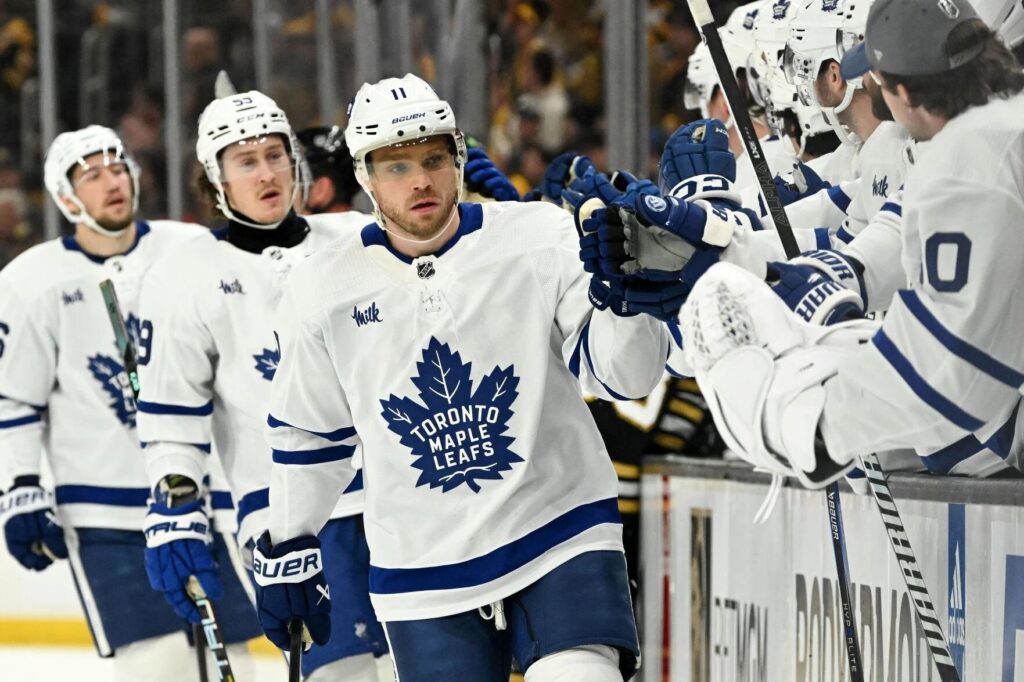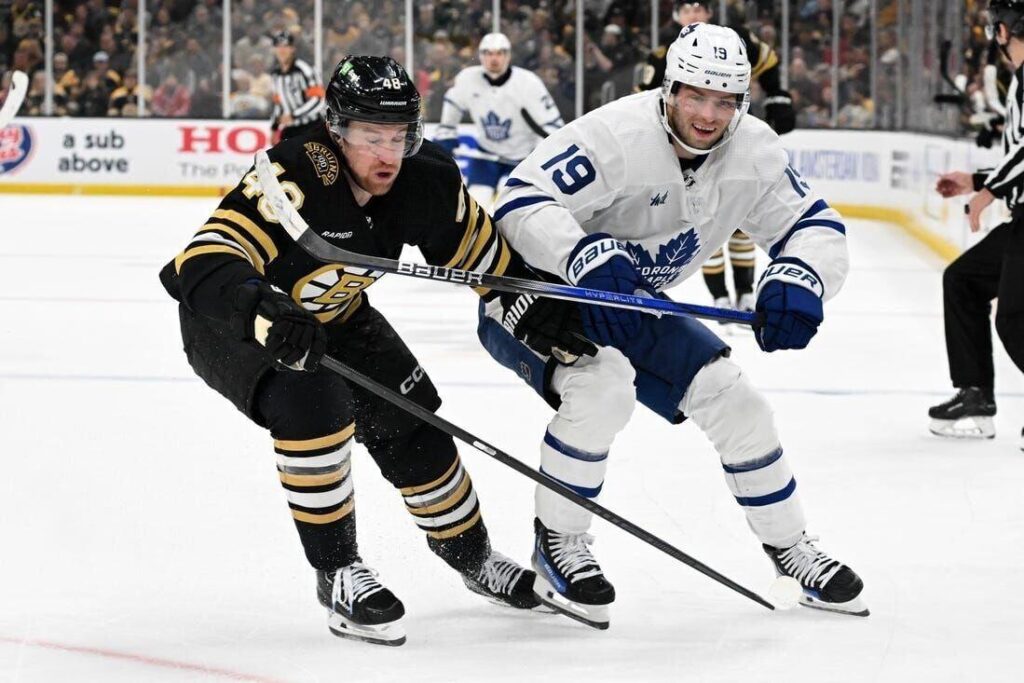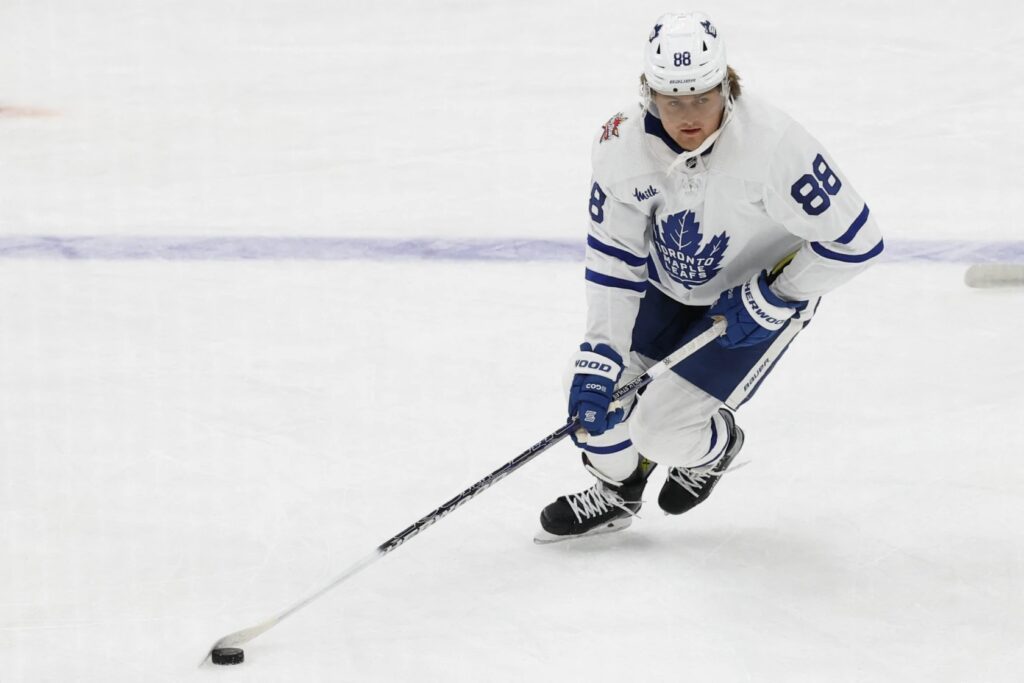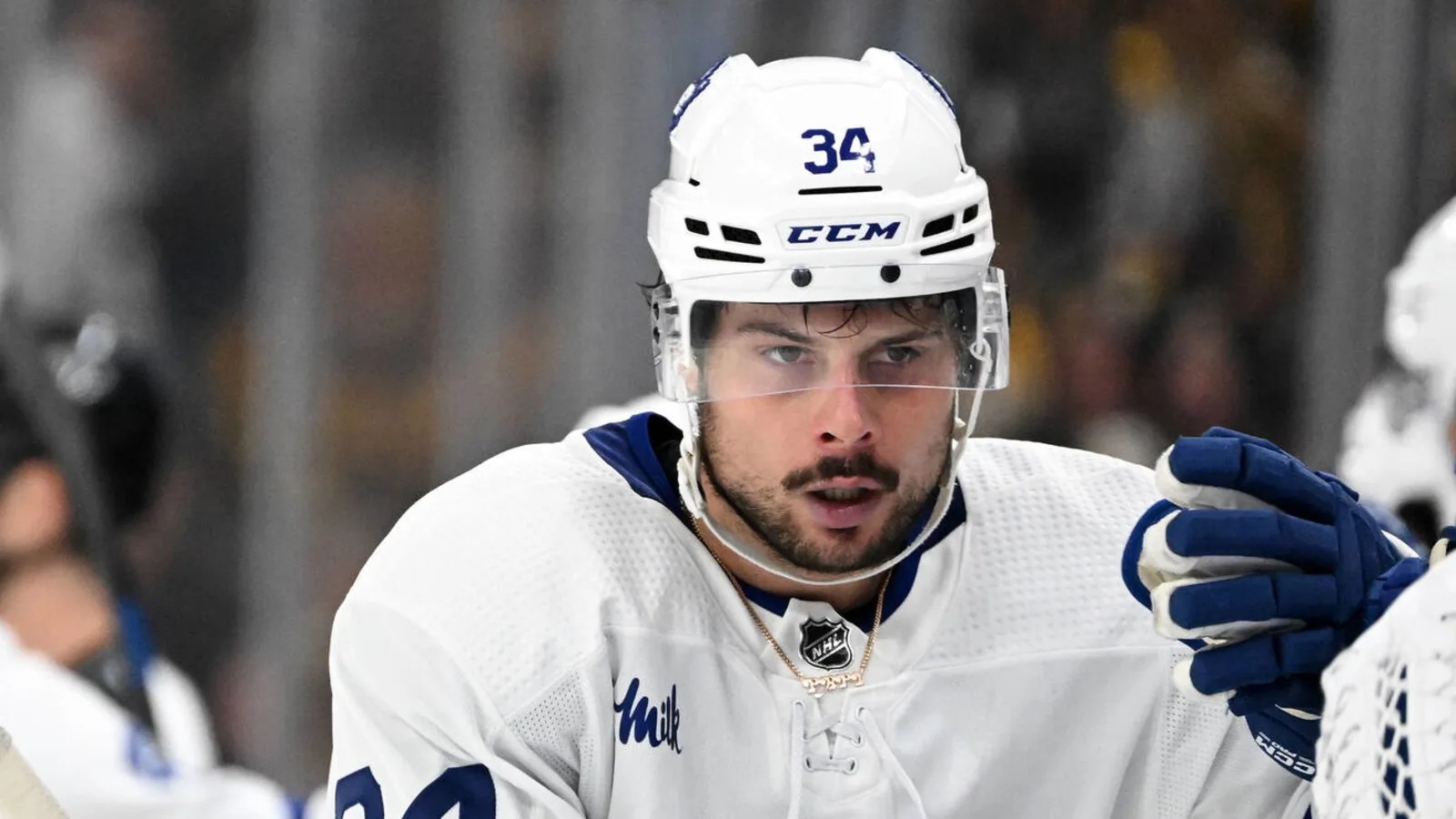In need of a big win to even the series, the Toronto Maple Leafs leaned on the brilliance of their best player and got a hard-earned victory.
Matthews’ goal and two assists were the main storyline, but the Leafs played a more composed game in Boston to take Game 2 from the Bruins 3-2. Max Domi and John Tavares both scored, Ilya Samsonov was much sharper, and the Leafs cut down on the mental lapses (albeit not perfect). Much to discuss on the trip back to Toronto:
Turning Points

The turning points of this game really could be any of the Leaf goals, but I’ll go with the first and the last. The first one certainly stands out as a momentous turning point, probably the biggest of the game. Boston had just scored yet another power-play goal against the Leafs, meaning they’d scored first for the sixth time in six meetings this season. A giant sore spot for Toronto struck again and the air started to come out of the balloon early… for about a quarter minute because the Leafs answered right back.
Responses after goals for or against can be so critical to a game’s outcome, and the Leafs‘ top line simply pulled up their sleeves immediately. They dumped a puck in and went after it on the forecheck, turning over a Bruins retrieval, and it wound up in the slot on the stick of Auston Matthews. He rifled a shot off the iron, and Max Domi put himself in the right spot for it, collecting the rebound and eventually jamming it by Linus Ullmark. Just like that, 14 seconds after Boston’s goal, the game was tied at 1-1. A huge moment to quickly yank the Leafs out of a possible tailspin.
And then, of course, there was the go-ahead goal, which shifted the game firmly from “looking for the breakthrough” to “time to put this one away” mode for the Leafs. Max Domi flipped a puck from just inside his own blue line up in the air down the ice. Matthews tracked it perfectly, snatched it out of mid-air, and dropped it on his stick blade with a step on Charlie McAvoy. He sped in on net all alone, deked to his backhand, pulled it back to the forehand, and scored over Ullmark — an absolute no-doubter of a finish. The Leafs now had a 3-2 lead with 7:54 to play in the contest, their first lead on Boston all season. Notable: Both goals came off of a direct north-south approach to the game from the top line.
In the minutes leading up to Matthews’ goal, there had started to be a bit of a “next goal wins” feel to the game. Indeed, it ended up being the case, as Toronto did a pretty admirable job of limiting the Bruins late, which included a pivotal penalty kill. As soon as the Leafs received that goal from their best player, the focus shifted to grinding the game out; shifts focused on getting it deep and killing the clock rather than aggressively pushing for a goal. It was a composed close-out effort, and the Bruins didn’t have the offensive juice to tie the game up.
Notable Performances

All the discussion about Game 2 revolves around the tremendous game by Auston Matthews, for good reason. He had a hand in all three Leafs goals and drove a highly effective line. The line of Matthews, Max Domi, and Tyler Bertuzzi was positive in every single underlying metric at 5v5, but the two that really stand out are the chance metrics. With the top line on the ice, the Leafs won the scoring chance battle 10-2 and the high-danger chance battle 6-1. That line delivered our two turning point goals, both plays with Matthews and Domi involved, and they were tremendous all night long, not only tilting the ice but routinely getting pucks off the wall and into the interior of the offensive zone — no easy task against this Bruins team.
Domi was a huge playmaker in this game, but obviously, Matthews deserves the most credit as the centerman and the line-driver. More importantly, it was a testament to what many have believed for a long time, which is that Matthews doesn’t need elite wingers to be on a great line. Just give him two complementary ones and he can deliver a star performance in playoff hockey. There were a few shifts where Sheldon Keefe loaded up the top line, but for the most part, it was Matthews/Domi/Bertuzzi, and they were excellent. Matthews played like a $13.25 M player in this game.
While Matthews drove his own line, Mitch Marner very much did not, and that’s an area for major discussion after this game. The Marner line with John Tavares and Matthew Knies was dreadful in Game 2, beaten in scoring chances 5-1 and high-danger chances 4-0, giving up the Pastrnak goal when man-on-man defensive zone coverage went awry off a draw between the wingers and Simon Benoit. Marner’s playoff record has long been under scrutiny, and he’s done nothing in this series to quiet the chatter down. Through two games, Marner has been pointless and outplayed in his minutes.
Everyone on the line deserves some share of the blame for being caved in, but Marner correctly receives most of the focus. 33-year-old John Tavares is simply not an elite play-driving caliber player anymore, and 21-year-old Matthew Knies is still evolving. It is Marner’s job to make this line go. When it doesn’t go, and Marner continues to look invisible in the offensive zone — kept to the perimeter, slowing play down with the puck, and apprehensive in puck battles — it’s a real problem. The Leafs badly need a better Marner to drive better results from this line in Game 3; the top line was so effective that there is no way the Leafs can move away from it just to get Marner going, nor should they have to.
The fourth line of David Kämpf, Ryan Reaves, and Connor Dewar had a very nice night, their second straight strong game. Ever since the disastrous opening shift of Game 1, this fourth line has been Toronto’s second-best line — lively, physical, and effective. They had one shift at the end of the second period, right after the Tavares power play goal, where Keefe put them out for the center ice draw, and Jim Montgomery matched them against the Pastrnak line, where they got brutalized. That’s a terrible matchup for obvious reasons. But every time the Leafs got the fourth line out against Boston’s fourth line, the Kämpf trio won the matchup decisively. Scoring chances were 4-1 in Toronto’s favour, and high-danger chances were 1-0 with that line on the ice. This group needs to stay together and continue doing what they’re doing because it’s giving the Leafs valuable momentum-building shifts in the secondary matchups.
There’s not a ton to say about the third line, which was Toronto’s least-used at 5v5 by a substantial margin, but they did their job. They didn’t get scored on, generally won their minutes, and came very close to scoring a goal. Nick Robertson was the victim of highway robbery by Linus Ullmark in the third period off a rebound from a Calle Järnkrok shot. This line won’t play a big role until some of its members are replaced by currently injured Leafs, but this was a solid showing in very limited action. In Nylander’s absence, Jarnkork, in particular, has been a veteran “fixer” who has really helped his inexperienced linemates in all three zones. He was at his versatile best in this game, jumping in with Knies and Tavares as needed or joining Dewar and Kampf in the close-out effort at the end of the game.
On defense, the Leafs did a solid job limiting chances at 5v5, but I didn’t think any particular defensemen really stood out. For a night where Toronto only allowed 1.86 expected goals against in 48.5 minutes of 5v5 time, it still felt rickety on the back end, and I suppose that’s the nature of this patchwork defense. Analytically, the Morgan Rielly and Ilya Lyubushkin pair graded out the best, but I didn’t note any particularly great moments from either player. Lyubushkin was Toronto’s least-used defenseman by ATOI alongside Simon Benoit, who had another up-and-down sort of game. He’s looked a bit overwhelmed at times through two games, which is understandable for a player with just over 200 career NHL games and zero career playoff games before this series. If the Leafs make a lineup change on D, it’ll probably be Benoit or Lyubushkin coming out.
Elsewhere on D, Jake McCabe took a stupid post-whistle penalty, although it was a dive by Jakub Lauko. The Bruins’ forward knew what he was doing and baited McCabe into it. It’s on McCabe for falling victim there and making a stupid decision, his second stupid post-whistle penalty against the Bruins in Boston this season (see: his cross-check on Marchand in March). McCabe’s got to be smarter and keep his emotions in check; otherwise, he took a step forward from Game 1 when he appeared caught off guard at times by the playoff pace regarding his decision-making with the puck. There was a standout defensive play to break up a Bruins odd-man rush as well.
The performance of Joel Edmundson seemed to draw some debate among Leafs observers after the game. Some seemed to view him as a scrub needing to come out of the lineup; others viewed him as one of Toronto’s best defensemen. Edmundson has his limitations, but personally, I was fond of his game. I noted a good clear from him on the last penalty kill, and he led Toronto’s D with five hits and blocked two shots. After the bobble on the d-to-d pass preceding the Pastrnak goal off the subsequent faceoff (he wasn’t on for the goal against, but he helped set the stage), he settled in with his puck movement. And he doled out a little hack on the feet to trip Charlie McAvoy as time expired, sending a little message into Game 3. It was more or less everything Edmundson was acquired to do. He’s not going to drive play and be some all-world defenseman, but he played a competent 22:38, second-most on the team among D. I would be surprised if he comes out of the lineup.
Lastly, Ilya Samsonov deserves a lot of credit for tonight’s game. I don’t think he was outright spectacular, but he was quite sharp after a two-goal first period and turned in the sort of resilient goaltending effort the Leafs are going to need more of to win this series. 27 saves on 29 shots included a massive rebound stop on Brad Marchand to keep the game tied early in the third period. He was steady, calm in the net, and dialed in late in the game when the Leafs were defending a man down (on the PK and in 5v6). It was a needed bounce-back game and his first truly “good” start in a couple of weeks.
Storylines for Game 3

1. William Nylander’s health. Same bullet point as after Game 1, but the status of a 40-goal, near-100 point scorer looms large over the series. It seemed like Nylander was closer to returning for Game 2 — he was on the ice for morning skate — but only time will tell. Not much else to say here other than the obvious: “The Leafs are vastly more dangerous with Nylander in the lineup.” Duh.
2. The penalty kill dilemma. The Leafs reversed a lot of negative trends after Game 1, but they were still unable to fix the penalty kill, going 1/2 in this game. Yet again, they were scored on by a goal-line down-low passing play that was simply too easy for Boston (this one started with an avoidable blown clearance, but it’s still concerning given it’s two similar goals in two games). Does Sheldon Keefe try something else with his personnel? Do they change something schematically? I don’t have the answers off hand, but that would be my main focus as a coaching staff on the off day and in whatever practice time they have available. The Leafs are outplaying the Bruins at 5v5, but they have to figure out how to clean up the special teams to win this series.
3. Defensive changes to the lineup? As I discussed in the previous sections, there is a possibility that Keefe will make a change. Given that he didn’t after a Game 1 loss, I’m rather skeptical that he will after a Game 2 win, but we will see. Lyubushkin and Benoit are the two possibilities to come out, while you’d imagine that TJ Brodie is the obvious player in line to draw in. Given his heavy usage there during the regular season, could Brodie be viewed by the coaching staff as a possible fix for the PK? If so, there becomes a bit of a pickle of where he plays since neither the Brodie-McCabe pair nor the Rielly-Brodie pair have looked all that effective as of late.
4. Last change opportunities for Keefe. As the series shifts back to Toronto, Keefe now has the opportunity for last change, which could be an opportunity to get Mitch Marner’s line going. In Boston, they were largely matched up against the David Pastrnak line, but perhaps Keefe can now find some opportunities to steal them shifts against Boston’s bottom six. Easier matchups leading to productive shifts could be the bit of confidence that they need to begin turning the tide in that matchup against the Pastrnak line.
The other side of this coin regarding last change and the matchup-exploiting opportunities it might create: The Leafs have been inconsistent on home ice this season. They need to bring a bit more of a road mentality at home, wherein they keep the game simple and establish a flow with their bench. Keefe has sometimes played into the issue by arguably “overcoaching”—loading up a line 10 minutes into the game versus Detroit while up 1-0 in the final regular-season home game springs to mind as a recent example.
5. The Bruins’ mystique is broken? This is the first time the Toronto Maple Leafs have beaten the Boston Bruins all season, after four losses in the regular season and Game 1. To put it plainly, the Bruins owned the Leafs up to this point, and finally, the blue and white dug deep and found an answer. Can they now look at this series for what it probably is (a winnable tossup) and not a difficult struggle against a team that has their number?
The return home for Game 3 should be viewed positively for the Leafs. They didn’t play perfect games in Boston, but the series is now a five-game affair, and they have home ice. They split on the road without Nylander and now may add him back into the lineup. They’ve been generally better at 5v5 through two games, and if they can clean up the penalty kill, there is a clear path to victory. Yes, the Bruins have been a difficult matchup for the Maple Leafs this season, but as we saw in Game 2, the Leafs are good enough to beat this team. Maybe they just needed to see a few finally go in against Boston’s elite goaltending to believe it.

































